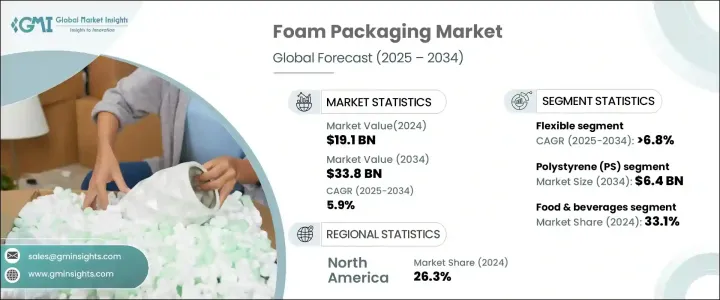
세계의 폼 포장 시장은 2024년에 191억 달러로 평가되어 2025년부터 2034년까지 CAGR 5.9%를 나타낼 것으로 예측됩니다.
보호적이고 비용 효율적인 패키징 솔루션에 대한 수요 증가는 특히 물품의 안전한 운송에 의존하는 업계에서 시장 확대의 원동력이 되고 있습니다. 경량이고 충격에 강한 폼 포장의 요구가 높아지고 있습니다. 전자상거래의 성장과 산업용 수출은 운송중의 제품을 보호하는 효율적인 방법을 기업이 요구하고 있기 때문에 이 수요를 더욱 촉진하고 있습니다.

또한 환경 문제에 대한 우려와 규제 강화가 생분해성 대체품으로의 전환을 촉구하고, 제조업체에게 환경 친화적인 발포체 솔루션의 탐구를 촉구하고 있습니다. 소비자가 재활용 가능한 소재와 생분해성 소재를 선호하게 됨에 따라 폼 포장의 기술 혁신이 가속화되어 바이오 대체품의 개발이 진행되고 있습니다.
| 시장 범위 | |
|---|---|
| 시작 연도 | 2024년 |
| 예측 연도 | 2025-2034년 |
| 시작 금액 | 191억 달러 |
| 예측 금액 | 338억 달러 |
| CAGR | 5.9% |
시장은 제품별로 경질 폼과 연질 폼으로 구분됩니다. 경질 폼 분야는 뛰어난 단열 특성과 전자기기, 의료기기, 식품의 보호에 널리 사용되고 있기 때문에 2034년에는 196억 달러에 달할 전망입니다. 지속가능성에 대한 규제가 엄격해짐에 따라, 제조업자는 바이오의 경질 폼 대체품에 주목하고 있습니다.
소재별로는 폴리우레탄(PU), 폴리스티렌(PS), 폴리프로필렌(PP), 폴리에틸렌(PE), 폴리염화비닐(PVC) 등이 있습니다. 폴리에틸렌 폼은 뛰어난 충격흡수성과 재활용성에 의해 2034년까지 CAGR 6.9%가 될 것으로 예상되고 있습니다.
시장은 더욱 최종 이용 산업별로, 식품, 의약품, 항공우주 및 방위, 전기 및 전자, 자동차, 소비재, 기타로 나뉘어집니다. 소비자들이 환경 친화적인 대체품을 요구하고 정부가 기존의 발포체에 대해 보다 엄격한 규제를 부과하는 가운데, 퇴비화 가능한 발포 트레이와 생분해성 발포 트레이가 지지를 모으고 있습니다.
지역별로는 북미가 2024년 시장 점유율 26.3%를 차지했고, E-Commerce와 가전 분야의 확대가 시장 성장의 원동력이 되고 있습니다. 미국의 가전 시장은 2025년까지 1,520억 달러에 이를 것으로 예상되고 있으며, 폼 포장 솔루션은 업계 전체에서 제품의 안전성과 지속가능성을 확보하는데 중요한 역할을 하게 됩니다.
The Global Foam Packaging Market was valued at USD 19.1 billion in 2024 and is expected to grow at a CAGR of 5.9% from 2025 to 2034. The rising demand for protective and cost-effective packaging solutions is driving market expansion, particularly in industries that rely on secure transportation of goods. Global trade and exports continue to surge, increasing the need for lightweight, shock-resistant foam packaging. E-commerce growth and industrial exports further fuel this demand as businesses seek efficient ways to safeguard products during transit.

Additionally, environmental concerns and stricter regulations are encouraging the shift toward biodegradable alternatives, prompting manufacturers to explore eco-friendly foam solutions. Companies are replacing conventional materials like expanded polystyrene (EPS) with sustainable options to align with green policies and reduce carbon footprints. Consumers' growing preference for recyclable and biodegradable materials is accelerating innovation in foam packaging, leading to the development of bio-based alternatives. Governments worldwide are enforcing stringent restrictions on plastic usage, pushing the industry toward sustainable packaging solutions.
| Market Scope | |
|---|---|
| Start Year | 2024 |
| Forecast Year | 2025-2034 |
| Start Value | $19.1 Billion |
| Forecast Value | $33.8 Billion |
| CAGR | 5.9% |
The market is segmented by product into rigid and flexible foams. The rigid foam segment is projected to reach USD 19.6 billion by 2034, driven by its superior insulation properties and widespread use in protecting electronics, medical equipment, and food products. As sustainability regulations tighten, manufacturers are focusing on bio-based rigid foam alternatives. The flexible foam segment is also experiencing significant growth due to its adaptability across various industries.
By material, the foam packaging market includes polyurethane (PU), polystyrene (PS), polypropylene (PP), polyethylene (PE), and polyvinyl chloride (PVC). Polyethylene (PE) foam is expected to witness a 6.9% CAGR through 2034, largely due to its excellent shock absorption and recyclability. The rise of e-commerce and the growing demand for electronic packaging are driving adoption, while advancements in cross-linked PE foam are enhancing durability and cushioning.
The market is further divided by end-use industry into food & beverages, pharmaceuticals, aerospace & defense, electrical & electronics, automotive, consumer goods, and others. The food & beverages industry held a 33.1% market share in 2024, reflecting the growing preference for sustainable foam packaging solutions. Compostable and biodegradable foam trays are gaining traction as consumers push for eco-friendly alternatives and governments impose stricter regulations on traditional foams.
Regionally, North America accounted for a 26.3% market share in 2024, with market growth being fueled by expanding e-commerce and consumer electronics sectors. The U.S. foam packaging market is expected to reach USD 7.2 billion by 2034, driven by increasing demand for protective packaging in online retail and the rising adoption of bio-based foams. With the U.S. consumer electronics market projected to hit USD 152 billion by 2025, foam packaging solutions are set to play a vital role in ensuring product safety and sustainability across industries.